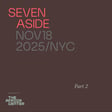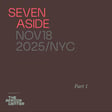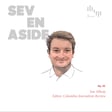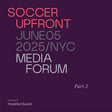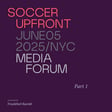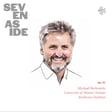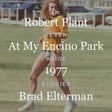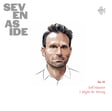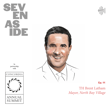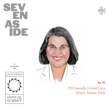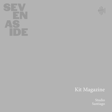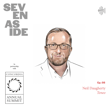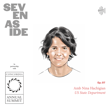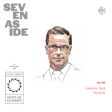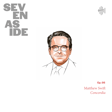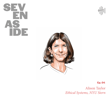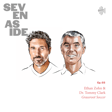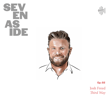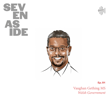Become a Creator today!Start creating today - Share your story with the world!
Start for free
00:00:00
00:00:01

Franklin Sirmans
The director of Pérez Art Museum Miami on leading and growing a young, international arts institution in the 21st century, staying agile amid shifting media and political currents, and what’s to come for FIFA World Cup 2026 and beyond
This episode is part of a spotlight on Miami for Kit Magazine's series on cities and sustainable development: https://kit-magazine.co/football-and-the-global-city/
Transcript
Franklin Sermons at LACMA and move to Pérez Museum
00:00:10
Speaker
In 2014, Franklin Sermons lit up the football world with an exhibition at Los Angeles County Museum of Art, LACMA for short, that brought together his passions of soccer and creative expression in a manner that very much drew from its Angelino and regional contexts.
00:00:24
Speaker
A year later, Sermons was bound for the East Coast, appointed director of Miami's nascent Pérez Contemporary Art Museum. The move put him at the forefronts of an institution and a city on the cusp of radical transformations. In nine short years, a period that encompassed a pandemic, political sea changes, and an awakening of climate consciousness, Sermons has guided the Pérez, or PAM, to international renown and a reputation for progressivism.
00:00:46
Speaker
It owes in no small part to an approach that embodies Miami's cultural panorama and deep connections to Afro-Caribbean, Latin American, even American Southern traditions, gives artists the space to challenge social, political, and environmental conventions, and reimagines the proverbial fourth wall, whether through the museum's physical architecture or its digital presentation.
The Pérez Museum's international acclaim
00:01:02
Speaker
Much of this was realized in a 2018 exhibition titled The World's Game, Football and Contemporary Art, a reincarnation of its LACMA predecessor.
00:01:11
Speaker
Sermon's Pérez is a museum looking outward, engaged in the big moments, striking out in the neighborhoods, actively expanding its reach in its hometown and internationally in thoughtful, meaningful ways.
Insights on leading a global arts institution - Q&A
00:01:21
Speaker
In this kickoff to our focus on Miami and prelude to 2026 World Cup North America, Sermon's gives us a sense of what it takes to manage and grow a young global arts institution in the 21st century, explains how Pam stays agile amid shifting media and political currents, and hints to what's to come for tournament time and beyond.
00:01:42
Speaker
Franklin Sermons, thank you so much for joining us. Let's start here. The Pérez has been dubbed, and this is a even a few years ago, one of America's most progressive museums. Reflecting on your now decade as director, how did the museum so quickly achieve this stature? what What about your blueprint, curatorially acquisitions-wise, even philosophically drives this? How do your own background and approach influence the mission?
PAM's history, design, and cultural integration
00:02:10
Speaker
Thanks for the question. I think, you know, the the interesting thing is like how how organizations, how institutions have different lives based on the people who are affiliated with them. And in our case, the funny thing is, you know, this museum began in 1984 and it was called the Center for Fine Arts. And the idea was just to bring art in from different places around the country, not to build a collection, just to show things and give people a place to do some of that. By the mid 90s, we became a collecting institution, as we call it, and started buying artwork and acquiring artwork and having to take care of artwork and became known as Miami Art Museum.
00:03:01
Speaker
um you know I came in in 2015, basically a year after we opened in our beautiful building on the Bay, which is like a new life, reincarnated as the Perez Art Museum Miami. So there's these three kind of different stages that have happened. And as somebody who came from a big institution in California and a big institution or relatively
00:03:33
Speaker
big imprint in the Menil Collection in Houston, I was ah able to be privy to a few building projects. And I would say that I knew I didn't want to go into a building project as a first-time director. But coming to a museum that had a brand new building done by Herzog and the Muran, done right on the water, I think architecturally suggestive of one of our you know attributes and missions is is to be um is to be open, inside, outside, to try and break down some of the barriers that a lot of people face or feel or perceive when it comes to the idea of going to a museum. And being in Miami, there are a lot of people who you know haven't had necessarily grown up with museum experiences, and we're trying to be that first experience for a lot of people. So you come to this museum,
00:04:33
Speaker
It's kind of inspired by ah a weird and interesting vernacular architecture called Stiltsville, which is a place down in Biscayne Bay, just south of us, where you had people who, you know for practical reasons, built houses on stilts in the water. Tide comes out. You're not so so high up. Tide goes in.
00:04:57
Speaker
um you have the ability to almost protect yourself against climate change. um and And of course, you know being a place where hurricanes have been a product of the place for a long time.
00:05:11
Speaker
It's no surprise that that kind of architecture gets made out of necessity. But our building uses that design. We sit on stilts. The parking lot is beneath the museum as ah as a way of of thinking through some of those things and thinking about where we are in terms of sight. The thing that I love is that It's predominantly glass. So there's no, like like, when I grew up in New York, the idea of going to the museum often meant climbing up these huge steps, you know, at the Metropolitan Museum of Art, the Greco-Roman kind of architecture that goes back thousands of years. And we're not that. We are inside and outside have to be almost, you know, imperceptible in a way. And so that's, I think the architecture
00:06:03
Speaker
And location fits into our mission and vision, which is to be a museum for everyone. and And I think we have the ability to do that in a place like Miami, where those experiences are still relatively um nascent in some ways.
00:06:17
Speaker
Well, that's interesting. your Your tenure and the museum's ascent ah correspond to a period of extraordinary growth and change for Miami and its place on the international stage. um How has the Paris been a reflection of, and and perhaps this is more about the collections, or for that matter, reaction to the city's new economic, social and political dynamics?
Focus on Latin American and Caribbean art
00:06:40
Speaker
So I think that, you know, the nice thing like about time is that you get to see and and and feel different experiences and we try to move with time. So and I remember when I got here in 2015, I think, you know, I had a lot of friends in New York and LA and even Houston and Chicago for that matter who were like, you're going where? To live? Like you mean to visit, not to live.
00:07:08
Speaker
And so you obviously, that that kind of perception has changed of this place. But um at the time, it it wasn't necessarily that. And for us, the idea was we are in a place that is a little bit off the beaten path. We know we're in a place that looks a little bit different than other places. That sounds a little bit different, right? I forget the numbers off him, but it's like 75% speak a language other than English.
00:07:38
Speaker
50% are from somewhere else, if not higher. ah So so it's ah it's it's built off of a demographics that is, I'm not gonna say unique, but certainly um certainly is specific.
Football-themed exhibitions and Miami's soccer culture
00:07:56
Speaker
And our, what I've tried to do is really capitalize on that, you know to say that there are many museums in the world that are dedicated to modern and contemporary art.
00:08:08
Speaker
So what? How are we different? How are we unique in that conversation? And what we've said and what we've done is that we were going to lean into the idea of wanting to be the best at presenting the work of Latin American art and artists.
00:08:25
Speaker
And we look at the Caribbean as being a big part of that conversation, in addition to looking toward the African diaspora. So you look at those those points of departure and that sets us alone and in in some ways, right? I mean, sure, you could say that museums in Los Angeles are dedicated to somewhat similar spaces or Texas, somewhat similar spaces, but not the way that we can with our proximity to the Caribbean and to the Atlantic.
00:08:54
Speaker
And so we've tried to really double down on that. And that's been a major way that we've grown the collection and in effect symbolized our mission and vision to be a museum that is unique and that speaks not only to its own specific location, but speaks to the world.
00:09:15
Speaker
ah But we'll come back to some of that in a moment. um In 2018, in the lead up to World Cup Russia, you reprised for the Perez, an idea you debuted at LACMA for Brazil 2014, an exploration in ah football in contemporary art. I did not catch the LACMA exhibit, regrettably, but recall it vividly as a defining moment for the game in America's cultural consciousness to say nothing of well ahead of its time when you consider how far things have come since. The PAM exhibition was roughly three years into your directorship,
00:09:45
Speaker
walk us through your inspiration to revisit the idea. How did it differ from its Los Angeles predecessor? How was it received in Miami versus l LA? And most of all, how did it uniquely fit your mission and vision for Pam? Oh, man, you know, yeah as you and I know, it's it's the beautiful game and it translates anywhere and everywhere. But to come to a place like this and to recognize, I think, immediately the love and passion you know for good and bad that you saw demonstrated this past couple of weeks with the Copa. um To recognize that passion and to see how people feel about the game as part of their their life, ah it's just it's just incredible. and and And immediately feeling that, you say, oh my gosh, we have to be a part of this conversation.
00:10:42
Speaker
have to. And so yeah, this is right. I don't think, um did we have enter Miami at that point? I don't think so. You know, we didn't have any messy or any of that. and and And in many ways, I feel like it's still, this place is still a kind of interesting testament to the conversations around the game in this country in that I probably see just as many you know people um supporting ah Boca Juniors or supporting ah River Plate than you see um supporting and Inter Miami. you know So there's a passion here that goes
00:11:24
Speaker
deep, deep, deep in ways that other parts of our country just don't have that same sort of umbilical cord to football in the world. So we had to do the show. And and I was really fortunate in that, you know, we have a ah wonderful curator here named Jennifer Anacio who's from Brazil who who brought a whole other element of of the conversation um to our exhibition. And so it's it's something that,
00:11:54
Speaker
yeah I'm working on another iteration right now. To me, it's something that should happen every four years, just like the World Cup does, just like the Copas do. ah Going back to 2006, Trevor Schoonmaker and myself did a version of of this kind of
Art as socio-political discourse
00:12:10
Speaker
exhibition in a gallery called Robling Hall, which had venues in Brooklyn and in Chelsea.
00:12:17
Speaker
So then, of course, you mentioned the l LA show and then the Miami show. ah To me, it's it's it's really one of those things. And what can speak, you know, better or more eloquently to the intersection of art and sport than football, the beautiful game? I don't know anything.
00:12:37
Speaker
You know, you're talking about artists like Andy Warhol and God knows who, how many, um but it is something that really translates throughout the world. You had Kehinde Wiley, if I'm not mistaken, in in both exhibits. Absolutely, absolutely. were were there Were there artists specific to the Miami, the the PAM exhibition that that you thought emblematic of what you wanted to say?
00:13:05
Speaker
So yeah, we were, oh i gosh, as you mentioned, i was I think I had been here like almost three years. um So yes, it was definitely an opportunity to dig deeper. And what we ended up doing, we included a a few Miami artists. Gosh, names are escaping me at the moment. um But we also made a film about football in this environment and in the urban environment.
00:13:32
Speaker
of Miami. And so that meant like showing the the guys and and the women who were playing under the thruway down in Brickell. We did a whole segment on football at the Little Haiti, ah at the football team that they have in Little Haiti, both girls and boys. So we were trying to um bring some of those elements to the to the floor without a doubt.
00:14:03
Speaker
the football exhibition, no exception, Pam does not shy away from the political and social conversation, whether it relates to racism, inequality, imperialism, slavery, even late capitalism. In your view, what is the institution's opportunity, even responsibility as a quote, progressive museum to help guide the country's discourse and understanding of itself? I mean, you know, I think that's part of the reason of of being in museums is that what we're trying to do and what we would know we can do is provide people with um different ways of thinking. you know Artists, I think, are always at the forefront of new ideas, of innovation, of playing with new technology. And so as a museum, I think we have, um and a contemporary museum at that, we have a ah duty to to share
00:15:02
Speaker
and to present new ideas um to the world. So I think that's part of our remit. And then in the wider sphere of socio-political economics, et cetera, I think it's just about it's about listening to artists and being the place where there is an opportunity to share ideas and to hopefully have the art spark dialogue. People don't have to agree.
00:15:31
Speaker
And certainly I don't think artists are there to um make you know easily digestible answers. But hopefully what what it does is it's a it's a place for for creative thinking and it's a place to so think differently. And so we try to amplify the the work that we show with educational programs. Sometimes that is just pure fun because I think that You know, a lot of a lot of really important things happen when people are having a good time together in the same space. And then some of it is more scholarly. ah Some of it is designed for kids and some of it is designed for older adults. So we're trying to cover a swath of of humanity. And I think each and every one of us that is involved at the institution believes that art has the power to do that in a way that other
00:16:31
Speaker
parts of our lives just cannot.
Digital engagement and community programs
00:16:33
Speaker
Well, hand in hand with that, or organizational leaders of all stripes are factoring so-called political risk in their decision making. In such a charged political environment, one in which even state funding for the arts becomes a lightning rod, how might political risk factor for you on a day-to-day basis, given your exceptional breadth of stakeholders, the community, your benefactors, lawmakers, so forth? how do you navigate the currents while maintaining the viewpoint, the integrity, the critical thinking that you're referencing? Yeah, no, i try I try to be incredibly pragmatic about it. And I think like, you know, like people I admire, I mean, somebody like Michael Roth comes to mind. It's like we we surround ourselves by people who think differently. and And and we, you know, we get together and we talk about um the issues. And I think that
00:17:27
Speaker
when you have that kind of breadth of opinion, it allows for competing ideas to to play out in in the same space. So for us, I think we have ah almost 50 board members and then we got 120 plus on the staff side. And it's a real variety of people who are stakeholders in the institution. And I think it gives us a breadth of knowledge and experience um to confront some of those sticky issues that are part and parcel of of being a museum in the 21st century. ah That's what I'm trying, that's what I'm trying to do. Have you been, have you ever been caught off guard by any of the pushback to some of your programming? You know, so a weird thing happened when I first got here and I and um i blame myself. I mean, my own ignorance. um
00:18:24
Speaker
It didn't happen in the galleries, but we have a shop downstairs and one of the you know one of the the objects that was on display for sale was a little ah was a little paper, like make your sculpture yourself, make it your own sculpture kit. And it had like lee ah political leaders. It had like, I think Abraham Lincoln was one of them, but it also had um Che Guevara and you just, you can't do that. It was, it was, it was a mistake and, and, you know, wrote a mea culpa and the paper. But it was something we missed and I don't know how we missed it, but it's just, ah that was, that to to me, that was, that was a real interesting moment early on in which to think through some of these issues and to think about how different groups of people are affected by the things that you present.
00:19:22
Speaker
And so we try to be really mindful of that. You referenced the film earlier and you and and the PETA has launched PAM TV, a direct to consumer platform for your film and video collections just last fall. And I believe it's a partnership with the Knight Foundation, if I'm not mistaken. and How does it speak to your strategy and digital approach writ large? How over the years have you found a smart balance between online engagement and the visceral brick and mortar experience?
00:19:56
Speaker
Oh man, we've been so fortunate in that regard. It's it's almost ridiculous. um I mean, not only, okay, so first off, as you mentioned, the Knight Foundation, we are fortunate to be not only a night city, because there are several of them, um but to be in in the headquarters, to be ah where the foundation is centered and where the foundation has chosen to make its greatest commitments to to thinking, to education, to culture. I mean, they literally support everything that is about humanity understanding each other better throughout our entire South Florida region.
00:20:40
Speaker
so we're lucky in that sense we had the leadership of alberto barguin a brilliant person who who who lived through newspapers. He was a publisher. He worked for the um for for the company that that then developed the foundation. And he saw firsthand, he saw that newspapers were caught off guard, right? When digital began to come into effect and and things were being offered on the web, the the papers weren't ready. And he didn't want museums to be in the same position.
00:21:17
Speaker
And so he made it a part of his strategy and and and with other brilliant minds, um we're fortunate to have Victoria Rogers of the Knight Foundation on our board.
00:21:28
Speaker
um he set out to to make that a priority. And so part of that priority was supporting advancements in the usage of digital at places like us, but particularly at PAM. And so back in 20, I think it was 2019 or 2020, it must've been 2019, we actually hired our first leader of of of digital engagement at PIM, thanks to the Knight Foundation, a brilliant woman named Heidi Quicksilver, who had already done transformative things at the Rock and Roll Hall of Fame in Cleveland and has now gone on to the Broad in l LA and other places. and um And then COVID came, right? And it was like, oh, wow, we just are going to accelerate a five-year plan into about a five-month plan.
00:22:16
Speaker
and And so that's what happened. um we are ah Just like everybody else, we quote unquote pivoted ah within a few days and our public programs that were already scheduled went to Zoom. you know i had I think the first one I did was with Jerry Saltz and that was fun. I did a DJ friend DJ Stretch Armstrong from New York. I did George Clinton, you know, it was a moment to think a little bit differently. And, gosh, I don't know where we would be without that moment, to be honest.
00:22:52
Speaker
um It really propelled things. And now we have Jay Malika, who who was doing the same kind of innovation at San Francisco at SF MoMA for many years before coming to us two years ago. And that's where PAMTV comes from. Jay has put together a team. I think we have about half a dozen folks in that department now, which started off with one. And they are constantly thinking about how we can improve what we already do, um but also how we can amplify what we do via digital
Art addressing climate change
00:23:30
Speaker
engagement. And PAMTV is a direct kind of result of that. Well, I want to come back to that in a second. um But while we we
00:23:39
Speaker
Well, we touched on on the brick and mortar, and you mentioned the museum's physical design as a corollary to its sustainability principles and and commitments. As Miami-Dade flexes its climate leadership yeah and looks to engage the public in the effort at that, how does PAM play a role? what Where does it fit into the equation?
00:24:01
Speaker
Yeah, this goes right back to you your're your your brilliant question about how we function you know as a museum vis-a-vis global issues. And I think what we can do is you know we're the visual arm in the conversation. And so it was wonderful to have, ah yeah I guess,
00:24:25
Speaker
With all of the emphasis on the conversation and with Miami being what it is in that conversation, we got to be a part of that. We sit directly on the water. And we have a huge neon on the south side of our building right now by the LA artist Andrea Bowers that literally spells out climate change is real. It's a beautiful piece, super colorful, different different colors. And so that's a beacon. ah You come inside, you got an exhibition downstairs called Sea Change.
00:24:58
Speaker
ah also taking into account climate change and and and changing weather patterns um throughout not only Miami but the world. And then upstairs we did a little show called Spirit in the Land which came to us from the Nasher at Duke. And so together these three shows are all kind of touching on some of these issues. They're not prescriptive, they're not scientific, but what they are is artists making work that probes the underlying issues of these very, and very important things that are part of all of our world. And I think that's what we do. That's who we can be. We can be a catalyst in terms of innovative conversation that hopefully leads people to think differently and to create things in a more successful or a more humanitarian way.
00:25:57
Speaker
When you, going back to PAM TV, and when you look to the next 10 years, what is top of mind for you, for the museum? Well, I think PAM TV is a testament to what we're trying to do. We like to talk about connect, amplify, sustain. And so what we're trying to do is reach more people. We know that there are a lot of people, as you and I have touched on,
00:26:26
Speaker
that have come to Miami in the last few years and are choosing not only to be tourists, but to make it home. And a lot of those people come here with prior experiences with museums. It's fantastic, right? Philanthropically, our our environment is changing drastically, and we're the beneficiaries of that in many ways. But there are a lot of people here who really haven't had those experiences, who still don't know we're here, who who think of us as being you know downtown and being a museum that is not for everyone.
Global collaborations and future plans
00:27:01
Speaker
And so we're trying to break through those things. And I think PAMTV is one way of doing that. We've also recently installed
00:27:08
Speaker
a pretty big digital sign right next door to our building that is situated so that um drivers going back and forth between Miami Beach and and Miami ah will know that we're there. you know it's like ah It's like another beacon for people to know that there's a museum here and for us to show some of the artwork that we are presenting.
00:27:34
Speaker
So these kind of things, it's also summertime. So I'm really happy to say that, you know, we have a program that's been ongoing for the last like 15 years called Pam in the Neighborhood, where we go to the neighborhoods that we know from looking at the zip codes and looking at the data of people who come through, we know that we're not getting more than two, 3% of folks from certain neighborhoods. So let's go to them.
00:27:59
Speaker
And we're doing our teaching artists are taking materials and supplies and doing art projects out in different places throughout the community. and And I think that's super important. So we're trying to we're trying to build and we're trying to do this because we think and we value the experience of museums and of people having that as part of their lives and we want to share that with more people. So PAMTV is one of of of several ways of doing that.
00:28:33
Speaker
In my mind's eye, we've come close to 300,000 people in a year. I'd like to see us have a half a million people come through within the span of a year. But I also would like to see millions more, at least have experiences with the museum online. And that's what we're trying to do. And that's what what we're pushing for. Given your own background in major cities, as well as the museum's regional scope, might any international collaborations or satellites be in the cards?
00:29:02
Speaker
We are looking to do more, first first priority is more um collaborative things that are happening here in Miami on the ground. For instance, on PAM TV, you have actually, ah it demonstrates perfectly, I think the approach. So on PAM TV, there's a series of exhibitions that are digital based exhibitions.
00:29:25
Speaker
One of them is from a collaboration with Tonno, the film festival and digital film festival in Mexico City. So international in scope, ah part of our region, but definitely international in scope. And then another one is with Third Horizon, a Miami organization that has been doing incredible things with filmmakers for the last decade throughout the Caribbean in particular.
00:29:55
Speaker
And so we know that we can be really helpful in these conversations with the presenting stages that we have both online and in person. And so that's the kind of collaboration we're trying to create right now. We're trying to make right now. We're also working on on exhibitions with other institutions around the world and definitely see that as part of our global outlook. No matter how good we want to be,
00:30:25
Speaker
about presenting the work around us, South Florida, Latin America, the Caribbean, the African diaspora. We also are part of a global conversation and and we believe in a big human conversation that is global in scope. So we're trying to to to think about it that way, but it all kind of roots out from here.
00:30:45
Speaker
ah Well, lastly, there's a message from you that greets visitors in the museum's lobby, and it reads, Pam is at the forefront of the now, committed to making museums as much a part of people's lives as the sporting events that define Miami's events calendar. In less than two years from now, the biggest sporting spectacle lands on Miami's doorstep, and it's a tournament very much about the nexus of the Americas. How do you and Pam, given everything that we talked about, channel that energy? How are you at the forefront of that moment?
00:31:15
Speaker
Oh, man, you know it. where We come right back around to the beautiful game again. The leading question. we're ah yeah We're already cooking up an exhibition that has ah it has elements in two or three different spaces ah throughout the museum. And and and so you're going to see a really direct complementary visual and be experience um that will complement what's happening when the cup comes in two years. And that's really, really specific. And the lead up to that, we also are talking to various you know potential collaborators throughout the city. i mean you know
00:32:02
Speaker
FIFA has moved here. Last time um last time when when we did the 2018 show, we did it in presentation with CONCACAF and they came on as one of the sponsors of the show. i'm I'm hopeful to get FIFA as involved as possible and of course they're already working on things with our friends across the way mayor at Miami Dade College.
00:32:28
Speaker
So it's going to be, oh my gosh, it's going to be incredible 2026. football in the global city is kit magazine's flagship series on cities and sustainability um miami focus gets underway with this episode in a special print edition to publish for concordia's forthcoming annual summit during un n general assembly in climate week in new york city Whether in person or virtually, join KIT publisher Santiago and hundreds of delegates from the business, policy, and advocacy communities for three days of eclectic programming and provocative discourse zeroed in on issues of global import. 2024 Concordia Annual Summit runs September 23rd until the 25th. The complete agenda, speaker lineup, and all other particulars can be found at www.concordia.net. Thanks once again to this episode's guest, Franklin Sermons. Signing off for Studio Santiago and KIT Magazine, I'm Eben Howell.
